Mini 4WD
Mini 4WD is any miniature model within the mini scale of between 1/20 (1:20) to 1/48 (1:48) Scale (ratio). From 1986 to 2019, the term is popularized predominantly (99%) by a 1/30 (1:30) scaled, AA battery powered plastic model race car without remote control.[1] All four (4) wheels are direct-drive, thus "4WD" for 4-wheel drive, as opposed to "AWD" or All-wheel drive. This particular type of Mini 4WD uses horizontal side rollers to guide the vehicle along the vertical walls of the un-banked track for steering, providing speeds from 14 to 65 km/H[2] (9 to 40 mph) on the track. At scale, (multiplied by 30), 1:1 speed represents 420 to 1,950 km/H or 270 to 1,200 mph.
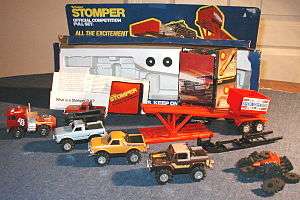

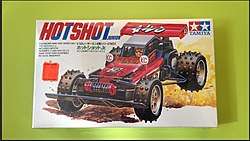
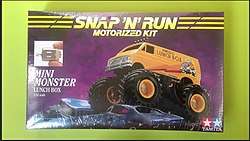
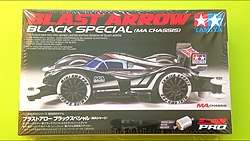
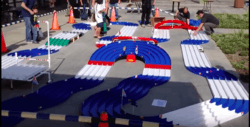
History
In 1980, the first, real mini 4WD series of vehicles, called Stomper 4x4 / Stompers (toy), were 1/32 scale and invented by Adolph Eddy Goldfarb[3] and produced by Schaper Toys of Minnesota, USA. Later, from 1983 to 1986, a smaller version of Stomper was distributed in McDonald's Happy Meals.[4] A multitude of replicas produced by other companies led to lengthy lawsuits, and eventually the company sold the product to Tyco, after which, sales declined.
The original Schaper Toys Stomper / Stompers (toy) vehicles of 1980 and subsequent Tamiya replicas of 1982 were heavily influenced by the worldwide craze for 4WD vehicles that started in 1979 with the inaugural running of the Paris Dakar Rally in 1979, which is evidenced by the particular make of those models. The first Shaper model vehicles produced in 1980 were the Ford and Chevrolet pickup trucks. The first Tamiya replicas produced in 1982 were the Ford and Chevrolet pickup trucks.
In 1982, a Japanese company, Tamiya, produced their own replica versions of the 1/32 scale Schaper Toys Stomper / Stompers (toy) that utilized worm gears and spur gears.
Also, in 1982, Tamiya mini 4WD kits were sold by Model Rectifier Corp (MRC), the exclusive U.S. Distributor of Tamiya.[5] The kits were manufactured in Japan while the boxes were printed in Canada. The kit parts were then packaged into the boxes in Edison, New Jersey, USA. MRC continued to sell Mini 4WD kits until at least 1990, which may be the year their Tamiya license expired.
In 1986, Tamiya produced their 4WD Mini Racer (ミニ四駆) series as a powered variant of their plastic automobile model kits. Interestingly, these highly modifiable racing model kits are larger at 1/30 scale, although still marketed as 1/32 scale. Due to the nature of these model kits being highly modifiable, racing and tuning up Mini 4WD cars has become a hobby for people across the world.[6]
In 1989, Tamiya commissioned Shogakukan, a Japanese publishing company, to produce two anime television series based on the Mini 4WD cars: Dash! Yonkuro by Zaurus Tokuda, Bakusō Kyōdai Let's & Go!!, Bakusou Kyoudai Let's & Go WGP in 1996, Bakusou Kyoudai Let's & Go MAX, and finally Bakusō Kyōdai Let's & Go!! WGP: Bousou Mini 4WD Daitsuiseki.
In February 1989, several American and Japanese companies unveiled their versions at the annual toy fair in New York.[7]
In November 1989, Jesse Ventura, retired U.S. Navy Seal, retired professional wrestler and former governor of Minnesota, USA, participated in a nationally televised competition near Chicago, USA which was provided by Hasbro, makers of the Mini 4WD, Record Breakers: World of Speed.[8]
Also in 1989, Tamiya America was established in the United States and replaced MRC as the officially licensed distributor for Tamiya, in that country.[9] Headquartered in Irvine, California, Tamiya in the United States held the USA Mini 4WD Championships at Marukai Corporation U.S.A. in Gardena, California from 2012 to 2015.
In 1994, in a town of Sicily, Messina, a group of kids began experimenting street racing inspired by the anime Dash! Yonkuro. This category of racing grew into a worldwide success by 2017 and continues to grow in recognition and participation.[10]
In 1999, Tamiya Japan temporarily suspended the Great Japan Cup national championships for Mini 4WD racers.
By the 2000s, at least twenty-eight (28) other companies had ventured into the Mini 4WD market, and famously included Tokyo Marui, Kyosho, Academy, Auldey Animation and Toys[11], Circuit no Ōkami, Aoshima Bunka Kyozai, Matchbox (brand), Revell, Hot Wheels, Tonka, Hasbro, and Bandai. Most of them introduced their own lines of mini cars, while some, from China, produce counterfeit, sometimes low quality, replicas of Tamiya cars.[12] These replicas are sold in the Philippines under brand names such as Jiada, Jiali, AA, Yu Xing, etc.
In 2001, due to the introduction of S.T.E.M., Mini 4WD has been used extensively for educational purposes in schools around the world, for teaching science, technology, engineering and math.
Beginning again in 2006, Japan holds National Mini 4WD Championships in Spring, Summer and Autumn each year[13] and by 2012 Mini 4WD was popular in more countries including Thailand, Singapore, Malaysia, Indonesia, South Korea, Canada, Germany, Italy, Russia, India and China. After a brief lull, there was a sudden resurgence of the popularity of the hobby in the Philippines in the last half of 2018, where racing tournaments happened almost every weekend.
The World Endurance Championship was first run in 2012 as a replacement for the Intercontinental Le Mans Cup and has increased its influence on Mini 4WD ever since.
From 2013 to 2018, Tamiya produced several kits based on FIA World Endurance Championship (WEC) cars, including LMP1, LMP2, GT1, GT2, GT3 and GT4 classes. The LMP1 and LMP2 models were based on the 2012 Toyota TS030 Hybrid, the 2014 Toyota TS040 Hybrid and the 2016 Toyota TS050 Hybrid.
According to Guinness Book of World Records, the world record for Longest Mini 4WD Track was created on 3 November 2019 at 3,191.58 meters at Amagi Dome in Izu, Shizuoka, Japan.[14]
From 2019 Street Mini 4WD category was officially supported by Tamiya Italia agent.[15]
Longest Mini 4WD Track World Records
| Date | Meters | Feet | Track | Country |
|---|---|---|---|---|
| 2019 November | 3,191.58 |
10,471.06 |
3-lane foam by Kimura | |
| 2014 February | 1,188.67 |
3,899.84 |
3-lane plastic by Tamiya | |
| 2011 March | 1,074.5 |
3,525.26 |
3-lane plastic by Auldey | |
| 2010 October | 523.61 |
1,717.88 |
3-lane plastic by Tamiya | |
Race Categories, Classes & Types
There are a few categories of racing for Mini 4WD and many classes and types. For example; Circuit Sprint Racing, Circuit Endurance Racing and Street Racing are categories.
Within the Circuit Sprint Racing category, there are many classes, such as Japan Cup, F-1 Series, Box Stock, Stock, Modified, Open, Technical, Speed-Technical, Semi-Speed Long Jump and Drag Racing.
Within the Circuit Endurance Racing category, there are many classes, such as LMP1, LMP2, LMGTE Pro, LMGTE AM, GT1, GT2, GT3, TCE and more.
Within the Street Racing category, there are 2 classes, such as Normal and Wild. Within each class of racing there may be many types, where the types differ by minor modifications according to each host's own decision.
Circuit Sprint Racing
Circuit Sprint racing is where the cars usually run on a 2, 3 or 5-lane track made of plastic or wood. Due to the nature of the lane-changing mechanism and for the purpose of cycling through a multitude of participants, a 2-lane race lasts 2 laps, a 3-lane race lasts 3 laps and a 5-lane race lasts 5 laps. Typical sprint track circuit lengths are usually between 20 and 200 meters. At an average track speed of 20 kilometers per hour, a car is able to finish the entire race in 3.6 to 36 seconds, respectively.
Circuit Endurance Racing
Circuit Endurance racing is where the cars usually run on a 1, 2, 3 or 5-lane track made of plastic or wood. Due to the nature of endurance racing, the minimum length of time for an endurance race is one (1) hour. Typical endurance track circuit lengths are usually between 200 and 2,000 meters. At an average top track speed of 20 kilometers per hour, a car is able to complete 20,000 meters per hour. Thus, during a four (4) hour race, a car may complete 80,000 meters. The longest endurance race is 24-hours where a car may complete 480,000 meters in that time. That is equivalent to 480 kilometers or 298.3 miles.
Street Mini 4WD
Street Mini 4WD is a category where the cars run on the street, parking lot, sidewalk, grass, gravel, sand or other ground, including RC tracks, without the use of a standard plastic Mini 4WD track circuit.
Street Mini 4WD drivers follow their respective cars, on foot, using a guide stick, much like a hockey player would use, to maneuver their car left or right through the race course.
The Street Mini 4WD races are based on the races that were represented in the manga and anime Dash! Yonkuro and the ongoing Hyper Dash! Yonkuro.
As of 2016, many communities around the world organize events in this category using common shared rules developed in Italy by the first Street Mini 4WD community, officially supported by Tamiya Italia.
Generations (1980)
Stomper 4x4s was the first official mini 4wd, created on February 14, 1980, by Adolph Eddy Goldfarb[16] and sold by Schaper Toys. These toys were battery-powered vehicles that ran on a single AA battery and featured four-wheel drive. They were driven by a single motor that turned both axles. Of the first vehicles were a Ford Truck and a Chevrolet Truck.
Generations (1982)
In 1982, Mini 4WD was produced by Tamiya. These toys were battery-powered vehicles that ran on a pair of AA battery and featured four-wheel drive. They were driven by a single motor that turned both axles. Of the first vehicles were a Ford Truck and a Chevrolet Truck.
Generations (1986-1989)
- In 1986, Tamiya produced a Racing Mini 4WD series starting with Hotshot Jr. and the Type-1 chassis. All Type-1 chassis kits were supplied with thick, big racing wheels and super slick spiked tires.[17]
- Emperor and the Type-2 chassis were introduced. Like the Type-1 chassis kits, all Type-2 chassis kits also have spiked tires of the super slick type.
- Vanquish Jr. and the Type-3 chassis with the standard large diameter tires and fin type wheels were introduced while the Type-2 Dash! Yonkuro cars were also re-released on the Type-3 with the same big racing wheels and smooth super slick tires.
- In 1989, Crimson Glory was released with the FM chassis, this unique chassis had the motor placed on the front of the chassis which was believed to give the car an upslope and downhill balance.
- In 1989, HASBRO released several versions of their Record Breakers: World of Speed series kits.[18]
- And in 1990, the Manta Ray Jr. and the Zero chassis were produced.
Generations (1990-1999)
- In 1993, Tamiya produced a Super Mini 4WD series starting with Liberty Emperor and the Super-1 chassis and it is the first series to only use the standard large diameter wheels and tires.[17]
- In 1994, Strato Vector and the Super FM chassis were produced.
- In 1994, Tamiya produced a Fully Cowled Mini 4WD series starting with Magnum Saber on the Super-1 chassis and it is the first to have cars equipped with small diameter narrow wheels and tires.[17]
- In 1995, Cyclone Magnum was released with the Super TZ chassis and wide thread wheels and tires.
- In 1995, Black Stalker and the Super TZ chassis were produced.
- In 1996, Tamiya produced an Aero Mini 4WD series starting with Max Breaker and the Super X chassis. In the same year, a Mighty Mini 4WD series was produced starting with Dyna Hawk.[17]
- Also in 1998, Lightning Magnum and the VS chassis were introduced.
Generations (2000-2009)
- In 2002, Tamiya produced the R/C Mini 4WD series starting with Subaru Impreza WRC 2002 and the TR-1 chassis, a chassis that runs with a receiver unit and a single-button radio controller. As the cheapest alternative to actual R/C cars and slot cars, the receiver unit is removable to let the car freely run on the track with just the motor and batteries, there were also car component kits and unique tune-up parts produced. However, the R/C Mini 4WD cars' popularity were not widespread after its introduction and Tamiya continued making free-running Mini 4WDs.
- In 2005, Tamiya produced the Mini 4WD PRO series starting with Nitro Thunder and the MS chassis, a chassis run by a dual-axle motor and can be separated into three parts: a front N-unit, rear T-unit and the midship unit containing the motor and batteries.
- In 2005, Bandai released Real Machines Series in collaboration with Toyota.
Generations (2010-2019)
- In 2010, Tamiya produced the Super-II chassis as the successor to the Super-1 chassis with more compatibility with optional parts meant for other chassis and as such were originally sold as premium versions of their original counterparts. Later in 2011, Tamiya started producing new Mini 4WDs on this chassis starting with the Astute RS.
- In 2012, Tamiya produced a Mini 4WD REV series starting with Aero Avante and the AR chassis, this new chassis has improved aerodynamics, easy motor and battery removal without removing the body part and a monocoque design.
- In 2013, Tamiya created the MA chassis series of cars as a subseries to the PRO series starting with Blast Arrow. The MA chassis combines the aerodynamics and monocoque aesthetics of the AR chassis and the inner structure aspects of the MS chassis.
- In 2017, Tamiya produced the FM-A chassis as a subseries to the REV series starting with Rowdy Bull. The successor to the Super FM chassis, it combines the aerodynamics and the monocoque aesthetics of the AR chassis with the front-mounted motor of the FM and Super-FM chassis.
Generations (2020-2029)
- In 2020, Tamiya created the VZ chassis as the successor to the VS chassis starting with the Neo-VQS. The chassis features a removable front bumper like the MS chassis and a rear roller stay that can mount four rollers.
Mechanical Display & Corporate-Sponsored Mini 4WD Models (Tamiya)
- In the late 1990s when Let's & Go!! MAX was aired on television in Japan, Tamiya produced a series of display model kits known as the Mechanical Mini 4WD series (stylized as Mini 4WD Mechanical). The cars in this series are static replicas of the mechanized cars shown in the anime itself and thus they cannot freely move unlike the actual Mini 4WDs.
- Certain software, anime production companies and some regions in Japan also collaborated with Tamiya to merchandise the main and/or secondary characters of their anime, software mascots or even tourism icons for limited edition Mini 4WD kits through licensing as these companies believed that Mini 4WD is cheaper for them to invest in bulk quantities compared to R/C cars which are four to six times the price per kit in bulk.
Mini 4WD Design
In a standard 4WD design, the separate four wheels are allowed to rotate at different speeds through the use of differentials. This is important for cornering to eliminate binding. In a Mini 4WD, this is not a standard design and is only achieved through optional one-way wheel sets. Thus, the standard Mini 4WD utilizes a direct drive to all 4 wheels even around corners. Chassis' are designed to hold the motor and batteries in differing arrangements. There are sideways motors positioned in the rear. There are sideways motors positions in the front. There are in-line motors positioned in the middle. Rear and Front position motor designs position batteries side by side in the front or rear of the motor placement. Middle position motor designs position the batteries straddling either side of the motor. Rear and front position motor designs utilize a propeller rod extending from the main motor gear box that drives both the front and rear axles. Middle position motor design powers both the front and back wheels through separate gear boxes eliminating the need for such a propeller rod.
Chassis are designed with front bumpers, optional side and rear bumpers designed to hold guide rollers that interact with the track's 58mm high walls.
The body is designed from hard plastic or soft, transparent Polycarbonate, known by the trademarked names Lexan, for special or limited editions, which attaches with a catch-type lock at the back of the car, distinguishes one model from another.
Motors
There are three specifications that characterize all motors: RPM, torque, and power-consumption.[19] RPM is the speed the motor provides, and the torque its strength. A higher RPM means higher maximum speed, higher torque gives more acceleration and allows the car to better withstand the difficulties of climbing slopes or running through turns.
The motor is one of the important components a mini 4WD racer need to make the car move, There are two types of motors: single-shaft or double-shaft motors.
Gears
Different types of gears have different ratios of rotation of the motor and the wheel, and they include (3.5:1), (3:7:1), (4:1), (4.2:1), (5:1), and "Special" (ratio varies but are usually 6.4:1). The higher the ratio, the better the acceleration rate and torque; the lower the ratio, the better the maximum speed.[20]
Tires and Wheels
It is recommended that, among the different wheels available, the compatible ones must maintain the same size as those from the assembly packet. The smaller the diameter of the wheel, the more stable it is, as the car's center of gravity is lowered. Although one can easily assume that a larger wheel suits a faster car the best, this is not at all the case. Large wheels are for cars with high gear ratio (i.e. "5:1") and weak motor; small wheels are for cars with low gear ratio and strong motor.[21] Wider wheels allow for more stability but suffer from friction, and thus, the loss of speed; thinner wheels are intended for speed, but the car could be susceptible to flipping off the track.
There are four types of different wheels: normal plastic, one-way, aluminum, and lock-nut.[21] Normal plastic wheels are fine, but they are not adequate for really fast cars. They become loose after disconnecting them from the axle several times. Additionally, they create drag when the car going through turns as the axle locks the two wheels at same speed, since the outer wheel must cover more distance than the inner wheel (relatively to the turn of the course). One-way wheels allow either side to roll faster than the other when turning, and minimize the speed loss in turns. Aluminum wheels are very light, sturdy, and best for speed. Some aluminum wheels have preventive measures against loosening with the axle. However, lock-nut wheels are the best in preventing the cars from losing the wheels during a run.
There are four types of tires: rubber, sponge, reston, and semi-pneumatic.[22] Rubber tires come as standard with the Mini 4WD, and, although it has good grip, it is heavy and is susceptible to slipping on wet surfaces. The alternate solution to the rubber tire are the reston or sponge tires, which are very light, have good grip, and are better suited for rainy days. Yet, these get dirty easily, and they tend to exhaust the motor.
Bumpers
Bumpers are usually found at the opposite ends of the mini 4WD. Upgrading the bumper becomes a necessity as the mini 4WD is modified to run faster than what the stock kit usually runs. The faster the car, the more the car needs down force to counter the decrease in stability. The stock chassis+bumper combination does have a tendency to bend, causing the rollers to run at angles and may make the mini 4WD fly off the course. Aluminum, fiberglass, or carbon fiber plates are usually installed as after-market upgrades to prevent this from occurring. Another possible upgrade are the screws that keep the rollers to the bumper. Only Tamiya offers aluminum plates as upgrades.
Most after-market upgrade plates are usually wider than the stock bumper, and they facilitate the installation of "side extension" plates that make the front profile of the mini 4WD even wider.
Rollers
Roller is the wheel that rests on either end of the mini car's bumper and glides against the wall of the course. This allows the car to change direction and maintain stability. Conventional roller will do fine on a car with average speed, but, on a much faster car, aluminum or ball-bearing rollers must be purchased to acquire additional downforce and stability. These rollers do not tilt in angle as the conventional plastic rollers, and, therefore, have better chance in preventing the car from flinging off the course. Ball-bearing rollers have small metal balls around the internal ring, on which the roller spins, in order to minimize friction. Some rollers consist of two rollers on a pole -one at the base and other at the top-, so that they may offer the best stability. There are three types of roller arrangements. The first one is in which all rollers are same-sized, and this is for straight courses. The second arrangement, in which larger rollers are stationed in the front, is less stable when running through corners but minimizes speed losses; the third arrangement, in which smaller rollers are put in the front, is more stable when running through corners but the car is more susceptible to speed losses as it pushes into the wall.[23]
See also
- Bakusō Kyōdai Let's & Go!! Popular anime/manga based on Mini 4WD
- Tamiya
- Racer Mini Yonku: Japan Cup - Famicom video game
- Record Breakers: World of Speed
References
- eBay Listings Proof of Term Popularity
- YouTube Video Info on Mini 4WD Speed
- Autobiography of Mr. Goldfarb
- Minnesota Historical Society
- The Legal and Economic Aspects of Gray Market Goods By Seth E. Lipner
- Current Google Trends for Mini 4WD
- Chicago Tribune
- TIME Magazine
- USA Mini 4WD Championships
- Street Mini 4WD
- https://auldeytoys.nl/en/
- Historical Mini 4WD Box Art Gallery
- Mini 4WD History
- Guinness World Record for Mini 4WD
- Street Mini 4WD official Rules on Tamiya Italia website
- http://www.google.com/patents/US4306375 United States Patent Office for Stomper
- "Archived copy". Archived from the original on 2011-09-29. Retrieved 2013-11-25.CS1 maint: archived copy as title (link)
- Chicago Tribune
- Mini 4WD Motor Specs
- Mini 4WD Gearing Specifications
- Mini 4WD Extreme Info On Wheels
- Mini 4WD Hobby Info On Tires
- Mini 4WD Hobby Info On Rollers
External links
| Wikimedia Commons has media related to Mini 4WD. |
- Mini 4WD Community in United States
- Mini 4WD Community in Japan
- Mini 4WD Community in Philippines
- Mini 4WD Community In Indonesia
- Mini 4WD Community In Italy
- Mini 4WD Community In France
- Mini 4WD Community In China
- Mini 4WD Community In Hong Kong
- Older, Yet Good Reference Site
- Largest Mini 4WD Boxart Gallery & Historical Photos
- Mini4WD Online Track Editor